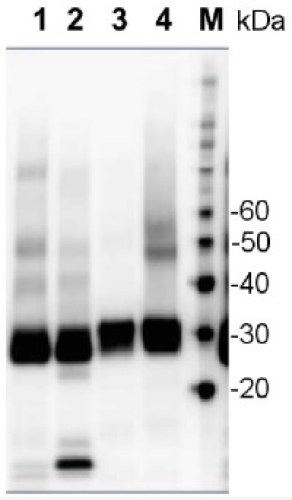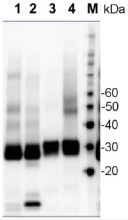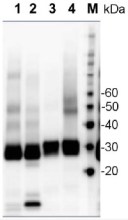
Anti-PsbA | D1 protein of PSII, C-terminal (affinity purified)
(Cat#: AS05 084A)


Description
- Immunogen: KLH-conjugated synthetic peptide derived from available plant, algal and cyanobacterial PsbA sequences, including Arabidopsis thaliana UniProt: A4QJR4, TAIR: AtCg00020 , Oryza sativa P0C434, Populus alba Q14FH6, Physcomitrella patens Q6YXN7, Chlamydomonas reinhardtii P07753, Synechocystis sp. P14660 and many others
- Host: Rabbit
- Clonality: Polyclonal
- Purity: Immunogen affinity purified serum in PBS pH 7.4.
- Format: Lyophilized
- Quantity: 50 µg
- Reconstitution: For reconstitution add 50 µl of sterile water
- Storage: Store lyophilized/reconstituted at -20°C; once reconstituted make aliquots to avoid repeated freeze-thaw cycles. Please remember to spin the tubes briefly prior to opening them to avoid any losses that might occur from material adhering to the cap or sides of the tube.
- Tested applications: Western blot (WB)
- Recommended dilutions: 1 : 15 000 (WB)
- Expected | apparent MW: 38 | 28-30 kDa
- Confirmed reactivity: Anabaena 7120, Arabidopsis thaliana, Artemisia annua, Arundo sp., Chlamydomonas reinhardtii, Colobanthus quitensis Kunt Bartl, Craterostigma sp., Coscinodiscus wailesii, Cynara cardunculus var altilis, Ditylum brightwellii, Glycine max, Hordeum vulgare, Lindernia sp., Miscanthus x giganteus, Marchantia polymorpha (liverwort), Nicotiana benthamiana,Panicum miliaceum, Panax ginseng, Panicum maximum, Paulinella chromatophora (amoeba), Pinus strobus, Physcomitrium patens, Prochlorococcus sp. (surface and deep water ecotype), Synechococcus sp. PCC 7942, Spirodela polyrhiza, Symbiodinium sp., Zea mays
- Not reactive in: No confirmed exceptions from predicted reactivity are currently known
- The psbA gene has been cloned from many species of plants, green algae, and cyanobacteria. The psbA gene is located in the chloroplast genome and encodes for the D1 protein, a core component of Photosystem II. PsbA/D1 is rapidly cycled under illumination in all oxygenic photobionts. Tracking PsbA pools using the Global PsbA antibody can show the functional content of Photosystem II in a wide range of samples. Alternative names: 32 kDa thylakoid membrane protein, photosystem II protein D1
- Kafri et al. (2023). Systematic identification and characterization of genes in the regulation and biogenesis of photosynthetic machinery. Cell. 2023 Dec 7;186(25):5638-5655.e25.doi: 10.1016/j.cell.2023.11.007. Wada et al. (2021) Identification of a Novel Mutation Exacerbated the PSI Photoinhibition in pgr5/pgrl1 Mutants; Caution for Overestimation of the Phenotypes in Arabidopsis pgr5-1 Mutant. Cells. 2021 Oct 26;10(11):2884. doi: 10.3390/cells10112884. PMID: 34831107; PMCID: PMC8616342.Sorrentino et al. (2018). Performance of three cardoon cultivars in an industrial heavy metal-contaminated soil: Effects on morphology, cytology and photosynthesis. J Hazard Mater. 2018 Jun 5;351:131-137. doi: 10.1016/j.jhazmat.2018.02.044.Kanazawa et al. (2017). Chloroplast ATP Synthase Modulation of the Thylakoid Proton Motive Force: Implications for Photosystem I and Photosystem II Photoprotection. Front Plant Sci. 2017 May 3;8:719. doi: 10.3389/fpls.2017.00719.Li et al. (2016). A Hard Day's Night: Diatoms Continue Recycling Photosystem II in the Dark. Front. Mar. Sci., 08 November 2016
- The antibody is appropriate for detecting both, 24 kDa or the 10 kDa C-terminal fragments, whichever is generated under given treatment conditions. In our analysis we have seen both, ca. 24 kDa and ca. 10 kDa fragments from different samples, depending on treatments and isolation procedures.Rabbit anti-PsbA antibody can detect more than one band of PsbA protein, e.g. precursor and mature protein as compare to the hen anti-PsbA antibodies AS01 016.This antibody will detect the phosphorylated form of D1 as an alternate band to the main band on a high resolution gel.The antibody will bind to cross-linked proteins: D1/D2, D1/cyt b559, D1/CP43.
Boca Scientific is your premiere source for high-quality, innovative solutions for Cell Biology, Molecular Biology, Immunology, genetics and other lab products and reagents. We bring leading-edge products from our own-line and around the world to laboratories in the US and Canada. Our goal is to offer excellent solutions to drive research and discoveries backed by superior customer support.
